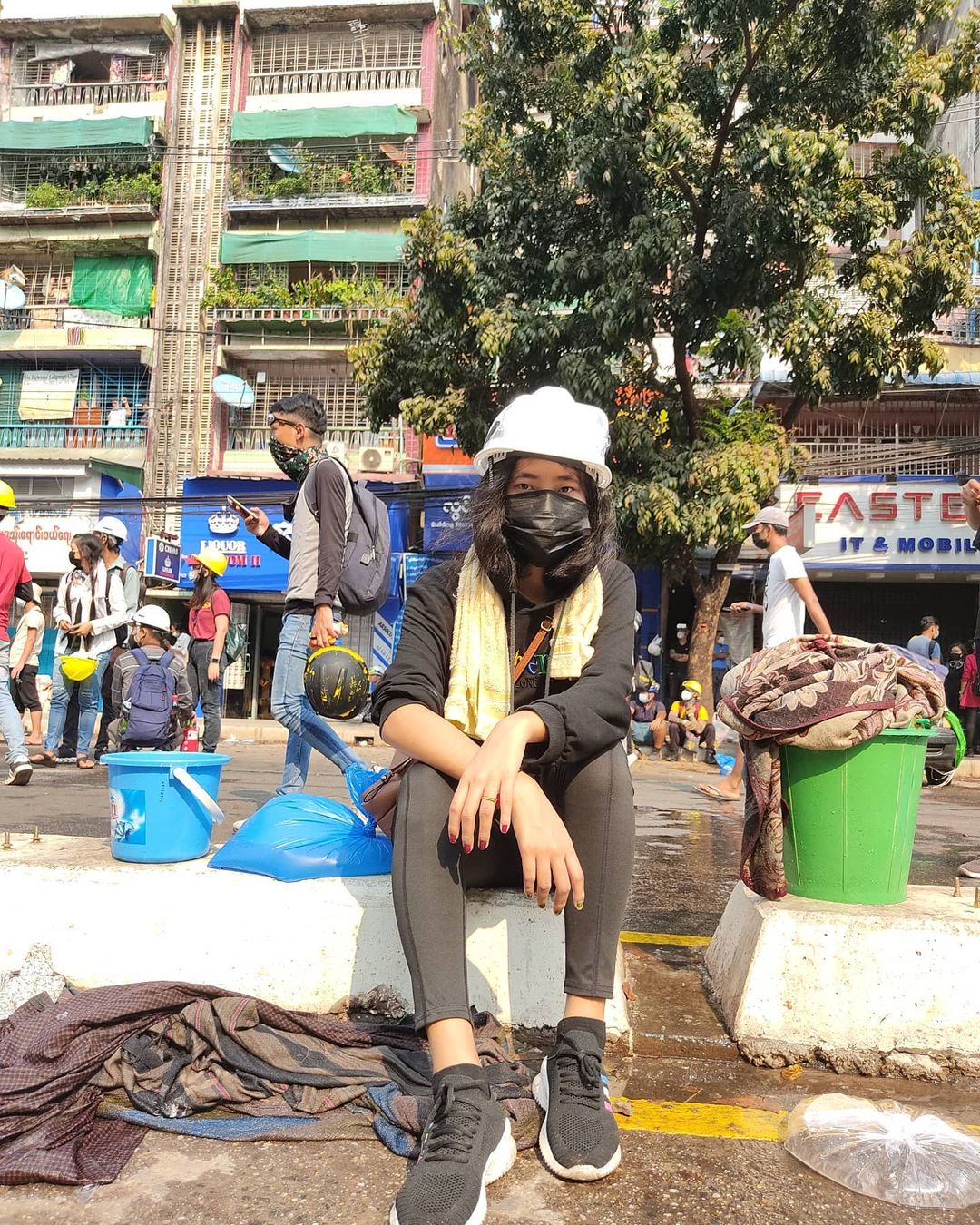Minds of the Movement
An ICNC blog on the people and power of civil resistance
by Ei Mon SoeSeptember 25, 2024
This article is part of the REACT mini-series entitled, "Voices of Resilience: Women Defending Human Rights in Southeast Asia", guest-edited by Maneesh Pradhan and powered by ActionAid Denmark. Additional posts will be released in the coming weeks. Check back on our blog homepage!
I will forever remember that hot, early-summer morning in February 2021. I was at the market near my apartment in Yangon, waiting for Shan noodles for breakfast. The breeze whispered that the Tatmadaw (Myanmar military) had taken power over the elected government led by Aung San Suu Kyi. I quietly finished my breakfast, shocked at the unexpected development, unaware of what it truly meant to live in a country undergoing a coup. When I got home from the market, I shouted to my sister, “စစ်တပ်က အာဏာသိမ်းလိုက်ပြီတဲ့” (the military took over). It was only then that I began connecting the dots and realized why the internet had not been working that morning…
The military imposed a nationwide internet shutdown, cutting off access to key social media platforms like Facebook. State-run TV channels such as MRTV went off the air, and later on, the military began broadcasting its announcements. Aung San Suu Kyi, State Counsellor and leader of the National League for Democracy (NLD), along with President Win Myint and other high-ranking officials from the NLD, were detained by the military. Such detainment created uncertainty and fear among the public. Soldiers and military vehicles appeared on the streets of major cities like Yangon and Naypyidaw, leading to heightened tensions. Banking services were disrupted, flights were canceled and many citizens rushed to stock up on essential supplies like food, fuel and cash.
Fear and confusion spread like wildfire. Yet amid the growing uncertainty, something incredible happened: thousands of men and women came out on the streets in peaceful protest against the military. Just two days after the coup, nonviolent resistance emerged. On February 2, 2021, a Facebook group named the “Civil Disobedience Movement” (CDM) was launched.

Protesters wore hard hats and masks to protect themselves from tear gas and other police violence. Credit: Author.
“Don’t move, stand still…”
Within hours, the Facebook group gained incredible traction, amassing more than 230,000 followers, giving way to street protests. Female participation was very strong even in the frontlines. At every protest I attended those first few weeks, I recall seeing as many women as men. Women’s involvement strengthened the movement, because they and gender/sexual minorities voiced their struggles, emotions and experiences, making the pro-democracy resistance more inclusive.
The coup had served as a trigger for pro-democracy resistance to coalesce; the Facebook group was helping amplify and give shape to that resistance. Doctors and medical professionals refused to work under the military regime, aligning their tactics with civil disobedience. Teachers, university professors, civil servants, bank employees and railway workers soon followed, amplifying the movement against the junta. The CDM quickly became a rallying cry for men, women, families and elderly people who opposed military rule and sought to challenge the legitimacy of the Tatmadaw’s actions.
I dropped out of university as an act of civil disobedience. Just the thought of pursuing my education under the junta left me feeling hopeless. It would have been such a shame. I happened to be living right near ground zero of these early protest gatherings, which made it easy to join them regularly. Everything was in order for me: participating in protests and sharing updates about “What is happening in Myanmar” on social media.
However, on the afternoon of March 3, 2021, I was standing with my two friends in the middle of thousands of university students who were joining the strike organized by the University of Yangon Students’ Union and All Burma Federation of Student Unions (ABFSU). We heard five successive, ear-piercing bangs. As soon as we heard this, hundreds of students who were standing on the frontlines of the crowd shouted “Don’t move, stand still!”, believing that we could bear this. As I peered over my fellow protesters’ heads, a colossal cloud of smoke had begun enveloping one-quarter of the crowd… I held my breath as at least 20 soldiers holding guns emerged out of the smoke, which had apparently come from tear gas. I had no idea what to do other than run away from the soldiers.
Amid the chaos, my friends and I became separated. At that time, I thought that I was going to die. As tensions mounted, fortunately some local elders guided students, including me, to a monastery where we could find shelter and regroup. I waited almost an hour with other protesters until the soldiers had retreated. On my way home, our elderly allies guided us along routes that were off the radar for soldiers.
I learned watching the news that evening that 389 of my fellow activists had been arrested, making it one of the most intense escalations in what has become a proper movement—the Civil Disobedience Movement (CDM)—and no longer just a Facebook group and spontaneous gatherings. The March 3 events became a notable moment in the movement and marked a turning point in our struggle against the regime. Above all, it taught us a harsh lesson: survival meant adaptation.
We soon shifted to dispersed tactics: quick, unpredictable and constantly on the move. We no longer stood still in large crowds. Instead, we scattered, regrouped and reappeared where the soldiers least expected. But it wasn’t just about physical presence anymore. Information became our greatest weapon. Protesters used encrypted messaging apps and virtual private networks (VPNs) to warn each other about approaching soldiers or informants lurking nearby. We were no longer just protesters; we had become shadows present everywhere, yet impossible to catch.

Credit: Author.
Intergenerational solidarity
Fast-forward to today, the CDM continues but has suffered many blows, making it all the more important to continue to adapt. Even facing such difficulties as displacement (impacting disproportionately women and children), imprisonment and torture at the hands of the Tatmadaw, why haven’t we given up this revolution? Why don’t people try to negotiate with the military regime, of course, to save future lives? Why do people still join the CDM even though their freedom, their lives are at risk? We have a clear answer: this generation is the last generation under a dictatorship. Our only hope is to win this revolution.
Our elderly allies—many of whom protested the military regime in 1988—believe, as we do, that the 2021 coup must be the last. With that belief, they have shared their knowledge, vulnerabilities and resilience practices with the younger generation to help us nonviolently struggle against the dictatorship. The ongoing revolution is a continuation of this earlier struggle. That is why the importance of intergenerational solidarity cannot be understated. This revolution is not just about one generation’s fight; it’s the combined strength of many generations, united in the belief that this time, we must end the dictatorship once and for all.
“Don’t move, stand still!” was the frontline protesters' cry on that historical day in 2021 when the junta cracked down on our nonviolent protest. Today, our priorities have changed, and we must actually continue to move and adapt. But we are for sure not going anywhere. We will stand strong. We will not give up the struggle.

Ei Mon Soe
Ei Mon Soe (Ei Mon) is an undergraduate student at PARAMI University in Yangon, Myanmar, after deciding to drop out of university under the military junta rule as a form of civil disobedience in 2021. She was a third-year law student at the time.
Read More